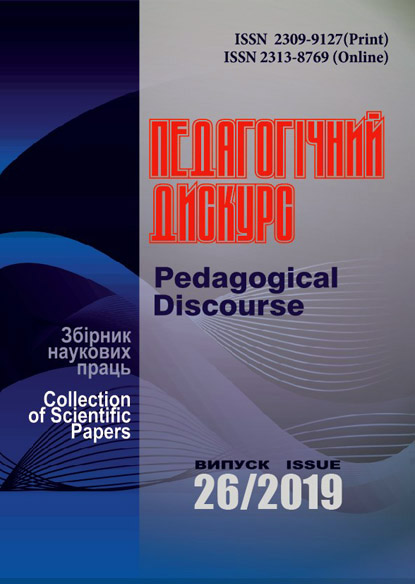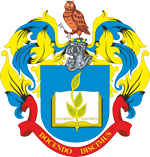Application of System and Synergetic Paradigm of Management of Social-Economic, Educational Processes in Ukraine
Abstract
Due to widening the system and synergetic methodology in the sphere of socio-economic research, the synergetic methodology is extrapolated on managing social-economic processes at the level of constructing the model of such a process. The research is consecutively conducted on three methodological levels – the general/overall (general principles of synergetics are realized in socio-economic sphere), the peculiar/specific (general principles of synergetics are realized in socio-economic systems management) and the single/individual (the synergetic principles of socio-economic systems management are realized in the sphere of education on the level of the model of educational systems management using temporary self-ruled managerial target teams). It is stated that the system-synergetic view of the world reveals certain fundamental aspects of the behavior of natural and socio-economic systems in the context of their control and governance. It is shown that the use of temporary self-ruled managerial target teams, being the major element of a synergetic model of socio-economic management, is realized according to synergetic principles and processes.
The use of temporary self-ruled managerial target team is realized according to synergetic principles and processes due to which we gain synergetic effect consisting in emerging and system (cooperative) phenomena. The teams are created quite spontaneously due to new educational (social) problems thus quickly reacting at outer environment’s disturbances. In this way, the teams can be considered to be open (dissipated) self-determined systems. The management capacity of the teams stems from their flexibility, multi-targeted nature and staff complexity since the members of the teams are recruited from various strata of society. Due to complexity and diversity of the teams they can react at different social fluctuations including the weakest signals of social-economic environment. The teams are quite self-determined and creative units since their temporary staff is recruited from different socio-economic establishments; so the teams’ members are not strictly fixed and are not materially dependant on team’s activities which gain creative character: one of the major characteristics of creative activities is connected with non-pragmatic orientation of the person involved in creativity thus revealing non-adaptive modus of a creative artist working according to the principle «the art for the sake of the art»).
Downloads
References
Ashby, W. Ross. (1956). An Introduction to Cybernetics. New York, J. Wiley. http://dx.doi.org/10.5962/bhl.title.5851 [in English].
Benedict, R. (1970). Synergy: Patterns of the Good. Culture American Anthropologist, 72, 320–330. [in English].
Bourdieu, P., Chamboredon, J.-C., Passeron, J.-C. (1991). The Craft of Sociology: Epistemological Preliminaries. Berlin, New York, Walter de Gruyter. http://dx.doi.org/10.1515/9783110856460 [in English].
Bruce, T. Grindal (2009). The Idea of Synergy and It’s Bearing on an Anthropological Humanism. Anthropology and Humanism Quarterly, 1(3), 4–6. [in English].
Bruce T. Grindal (1976) The Idea of Synergy and It’s Bearing on an Anthropological Humanism. Anthropology and Humanism Quarterly, 1(3). DOI: http://dx.doi.org/10.1525/ahu.1976.1.3.4 [in English].
Checkland, P., & Scholes, J. (1990). Soft Systems Methodology in Action. N.Y., Wiley & Sons. [in English].
Coleman, J. (1990). Fundations of Social Theory. Cambridge, MA. [in English].
Loye, D. (1989). The Partnership Society: Personal Practice. Futures, 21(1). DOI: http://dx.doi.org/10.1016/0016-3287(89)90064-5 [in English].
Fromm, E. (1975). The Anatomy of Human Destructiveness. New York, Bentan Books. [in English].
Haken, H. (1996). Synergetics as a Bridge between the Natural and Social Sciences II Evolution, Order, and Complexity. London and N.Y., Routledge. [in English].
Haken, H. (1995). An Introduction to Synergetics. Open Systems & Information Dynamics, 3, (1), 97–130. DOI: http://dx.doi.org/10.1007/BF02228811 [in English].
Kaznacheev, V. P., & Trofimov, A. V. (1992). Cosmic Conciousness of Humanity. Problems of New Cosmogony, Tomsk: Russia, Progress. [in English].
Kelso, J. A. S., & Haken, H. (1995). New Laws to be Expected in the Organism: Synergetic of Brain and Behaviour. Cambridge University Press. DOI: http://dx.doi.org/10.1017/CBO9780511623295.012 [in English].
Levin, K. (1955). A Dynamic Theory of Personality. New York, Penguin Books. [in English].
Maslow, A.H. (1976). The Farther Reaches of Human Nature. New York, Penguin Books. [in English].
Putnam, R. D. (1994). Making Democracy Work: Civic Traditions in Modern Italy. Princeton, New Jersey, USA, Princeton University Press. [in English].
Sorokin, P. (1985) Social and Cultural Dynamics: A Study of Change in Major Systems of Art, Truth, Ethics, Law and Social Relationships. New York: Imprint Routledge. DOI: http://dx.doi.org/10.4324/9781315129433 [in English].
Voznyuk, A. V., Grabar, I. G. (2008) The Analysis and Synthesis of Critical Phenomena and Quantitative Modeling of their Kinetics from the Position of Two-Dimensional Scaling of Points of Bifurcation. Collection of Scientific Works of Zhytomyr Military Institute, 1, 24–33. [in English].
Wiener, N. (1954). The Human Use of Human Beings: Cybernetics and Society. Doubleday Anchor. [in English].

This work is licensed under a Creative Commons Attribution-NonCommercial-ShareAlike 4.0 International License.

















